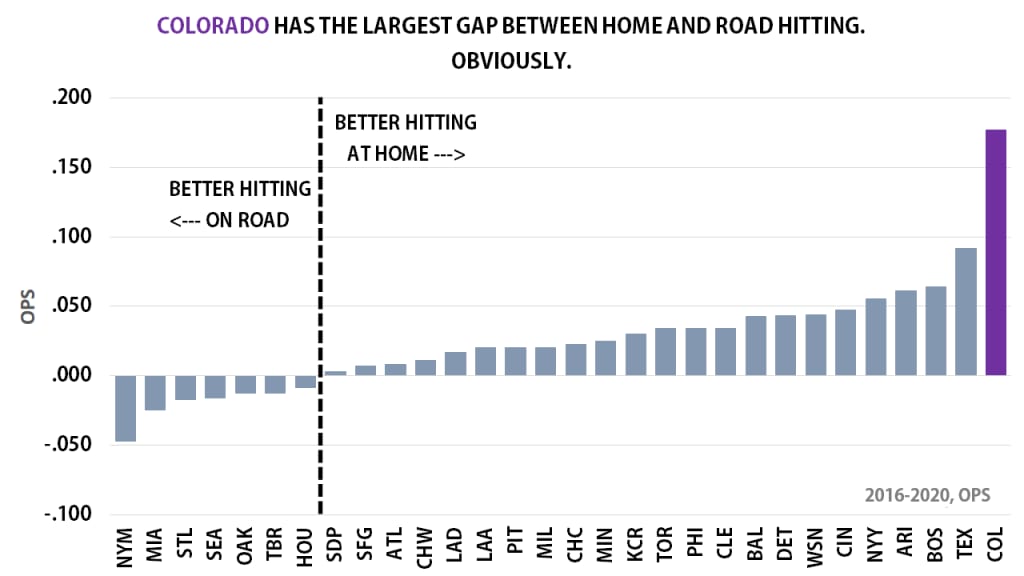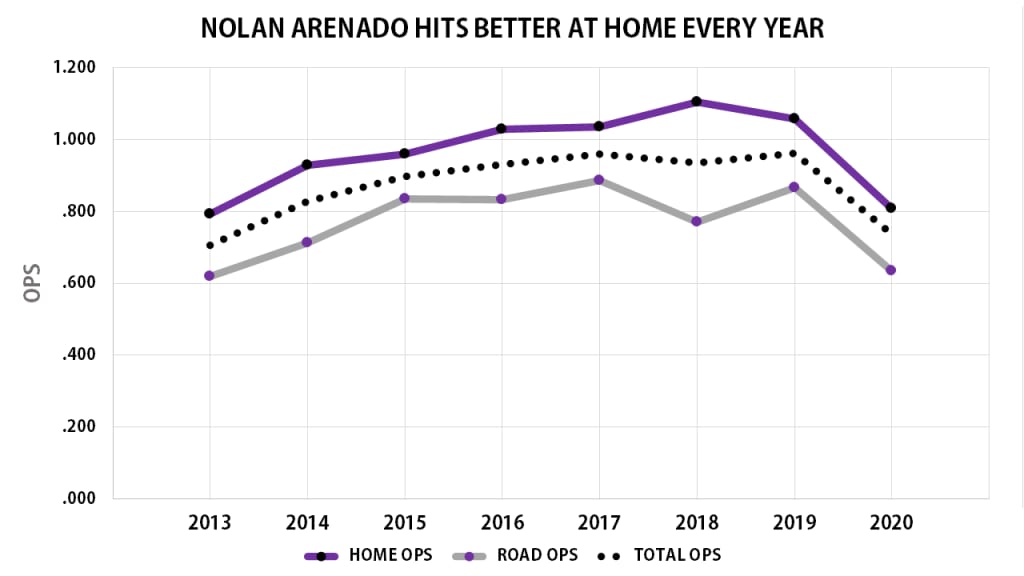This story originally was published on Nov. 20, 2020
Nolan Arenado is on his way to the Cardinals in a six-player trade with the Rockies. It's been clear that his frosty relationship with Colorado and its relatively weak outlook for the immediate future made a dissolution of their partnership seem imminent for some time.
It's been a complicated scenario, between his remaining contract ($199 million through 2027), his ability to opt out (after 2021), his full no-trade clause, the shoulder injury that marred his 2020 offensive performance, what the Rockies were seeking in return and the external factors of pandemic economics and the looming expiration of the Collective Bargaining Agreement, one year from now.
All of that is a lot more than we can unravel, so let's get to something a lot simpler, something that seems to come up every time we talk about the departure of a Rockies hitting star: No, he's not good simply because he's played in Coors Field.
You would have thought that the recent experience of DJ LeMahieu would have put an end to this, but apparently not. LeMahieu, you might remember, had regularly large home/road splits as a Rockie, culminating in a 2018 where he hit .317/.360/.433 at home, but a mere .229/.277/.422 on the road. That left so many worrying that his mediocre road line was "who he really was." LeMahieu, of course, went to the Yankees and hit .336/.386/.536 across two years, collecting MVP votes in each season. Not a product of Coors, right?
What happened? We first wrote about this back in 2015, though some of the images are now missing from that older piece, and again regarding LeMahieu on the day he signed two years ago. Coors Field helps you hit at home, but it comes with you on the road, negatively. Being a Rockie can make you a worse hitter in other parks.
Why is that? And what does it mean for Arenado, or more importantly now, for the Cardinals?
Wait, Coors Field does what?
It's counterintuitive, at first: How could your home park in Denver affect what you do in San Diego or Philadelphia or Miami? Part of it is simply the difficulty in adjusting from high altitude to sea level and what that does in terms of recovery. But it's largely about the way pitches move differently at Coors compared to how they do on the road, how opposing pitchers change their game to adapt and how hard it is to change your hitting approach between the two.
For example, people tend to think that what Coors does is create homers. It doesn't, really; it's mostly that the outfield is so large that it's impossible to cover, and lets a ton of extra balls drop in. But all of that only matters if contact is made in the first place, and Coors has a lot to say about that, too. At home, over the last two seasons, Rockies hitters have had the eighth-lowest strikeout rate (21.2%) ... and the third-highest road rate (26.7%). It's easier to make contact at home and it's harder for them to make contact on the road.
Let's go back to something we wrote in 2015, covering the years 2005-14, which might best illustrate the extent of the problem.
If we update that over the last five years, what do we see?
Team batting stats, 2016-20
OPS
Rockies (home) -- .862, best in baseball
Rockies (road) -- .685, worst in baseball
Runs scored
Rockies (home) -- 2,094, most in baseball
Rockies (road) -- 1,465, 27th-most in baseball
Still happening! This all seems compelling, though maybe a visual will sell it easier. From .862 at home to .685 on the road is a .177-point difference in OPS between home and road.
That seems big, right? How big? Quite big:

That list tracks, mostly. Citi Field and Marlins Park have been notoriously difficult to hit at in recent years, and the previous Texas ballpark (in use through 2019) was a considerable hitter's park. No one comes close to Colorado. (This also shows that most teams hit slightly better at home, which makes sense.)
The point is, what we wrote five years ago has remained the same, and it's not just about Coors making the Rockies look good at home, though it surely does. It also makes them worse on the road. For what it's worth, they're not blind to this; Charlie Blackmon, in particular, has really taken the lead in attempting to overcome this problem by changing the lineup's practice habits on road trips. That it hasn't shown a large result yet might be because the problem simply isn't easy to overcome, or that the lineup just isn't that good and has long had a lack of depth behind the top three or four bats. (It's probably both.)
In LeMahieu's case, he actually breaks the theory a little, because while he did get better on the road (his road OPS in his final two years with the Rockies was .729, which shot up to .793 with the Yankees), he got better at home, too. It seems like he just got better, which jives with a few other Rockies-turned-Yankees (Adam Ottavino, Mike Tauchman) and may be a different issue entirely.
A great example here is Matt Holliday, who played for the Rockies from 2004-08, then was sent from Oakland to St. Louis midway through 2009, where he remained until 2016. We'll skip the brief stints with the A's and Yankees, as well as his 2018 return to the Rockies.
Holliday, home OPS w/ Rockies: 1.068
Holliday, home OPS w/ Cardinals: .895
His home performance away from Coors got worse. Just like you'd expect, right? Now about the road ...
Holliday, road OPS w/ Rockies: .803
Holliday, road OPS w/ Cardinals: .853
... which got better. After he left the Rockies, he became a better road hitter. This is what happens, at least for players who still have enough of their prime remaining when they leave the Rockies. Arenado won't turn 30 until April, so he still has plenty of time to succeed.
What about Arenado?
As most Rockies do, Arenado has been better at home than on the road.

This is not unique, obviously. Almost every Rockies hitter performs better at home.
Thing is, we've seen that before, and it doesn't always last when they're gone. Just look at how consistently better at home longtime catcher Chris Iannetta was in the last few years of his first stint with the Rockies, then how consistently better on the road he was as he traveled through three other organizations, then how he again hit better at home in a return visit to the Rockies alongside Holliday in 2018.
The point here is not that Arenado will maintain that home performance with the Cardinals -- it's that the road performance would be likely to improve to help compensate somewhat.
And, for what it's worth, even if he's "just his road stats," which he's not likely to be, that's pretty good! Over the last five years, Arenado has an .827 OPS. You know who else has an .827 road OPS over the last five years? Anthony Rizzo and Michael Conforto do. Corey Seager is a tick behind at .822. José Abreu is barely ahead, at .838.
If Arenado can do that with the anchor of his home field weighing him down, imagine what he might look like on the road without the Coors factor. If there's a reason to be mildly concerned, it might be about the severity of that shoulder problem, though there's no indication of that being a long-term issue. He's still, obviously, the pre-eminent third-base glove in baseball, and that'll play just fine in St. Louis. You don't have to worry about the bat coming with him.
